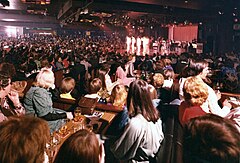Batley Variety Club
The Batley Variety Club was a variety club in Batley, West Yorkshire, England. During its heyday the club staged concerts by performers including Louis Armstrong, Shirley Bassey, Tom Jones, Roy Orbison, Eartha Kitt, Morecambe and Wise, Gene Pitney, Neil Sedaka, Ken Dodd and many more. At the peak of its success, the club had 300,000 members. It closed circa 1978 and reopened as Crumpets night club. It closed again shortly afterwards and its contents were auctioned off. It reopened as The Frontier in the early 1980s, and this closed in 2016. One hearing the news that building was no longer to be used as a venue, Shirley Bassey commented, 'I have many happy memories of singing at the Batley Variety Club so sorry to hear it is closing.' The building was converted to a gym in 2017.
The club was designed and built by James and Betty Corrigan in early 1967 on top of a disused sewage site on Bradford Road in Batley. The build took three months from start to finish, with floodlights erected so construction workers could work through the night to hit the deadline for opening on Easter Sunday. The build was interrupted when local authority inspectors discovered that the building was six inches too close to the road. Demolition took place and work continued but, despite this setback, the club managed to open on 27th March 1967 as planned. The headline act on opening night was The Bachelors.
James and Betty Corrigan had traveled to Las Vegas to research how the clubs worked there in order to work out a design for Batley. The ground floor of the club was excavated so that on entering, the public would walk down to their tables which would be arranged in tiers, five in all, forming a horseshoe embracing the stage from the bottom up, thus giving the audience unobstructed views. The ceilings were low, offering an intimate atmosphere, and the resident band was situated at the back of the stage rather than in a traditional orchestra pit so that the artistes could be closer to the audience. The club held 1,750 people seated, with standing room for more, and it was this large capacity which facilitated low admission prices for top quality acts. Food was served in baskets with plastic cutlery to avoid clinking noises that could disturb the acts on stage. There were two long bars than ran down either side of the club.
...
Wikipedia


